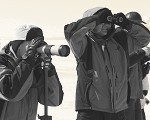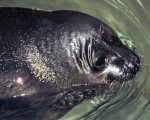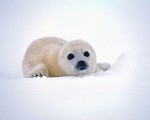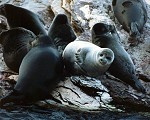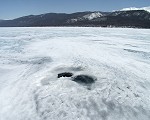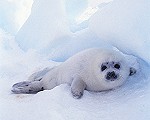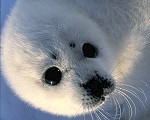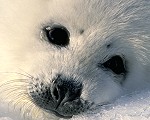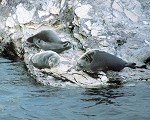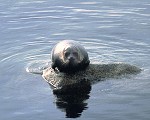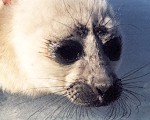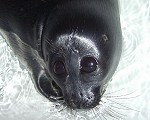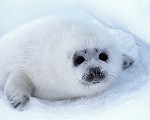| Origin & Development | |
|
Legends & Fairy tales • Earth's Crust Thickness • Underwater Relief • Landscapes • History & Formation • Seismic Activity • | |
| History of Lake Baikal | |
|
History of Explorations • Inhabitants & Settlers • First maps of Baikal • Archaeological Sites • | |
| Lake Baikal Climate | |
|
Introduction • Fogs • Winds & Waves • Ice Conditions • | |
| Fauna & Vegetation | |
|
Mammals • Baikal seal - Nerpa • Ichthyofauna • Invertebrates • Vegetation • | |
| Water of Lake Baikal | |
|
Colour • Transparency • Temperature • Pressure • Depth • Currents • Budget • Chemical Composition • Pollution • | |
| Recreational Areas | |
|
Circumbaikal Railway • Peschanaya Bays • Olkhon Island • Chivirkuysky Gulf • Wooden Irkutsk • Trans-Siberian Railway • | |
| People of Lake Baikal | |
|
People of Siberia • Buryat nation in Baikal • Russians in Baikal • | |
|
| |
| Lake Baikal Seals - NERPA "The Face of Baikal - Nerpa" - research work by Vladimir D. Pastukhov ©
This mass of large bodies on the ice, the inhabitants of Baikal's great body of water, bewitched me, and I made further observations of nerpa later - in November, December, and January... over the period when ice forms on the lake. All these observations were set down in my first scientific article, and the topic of the nerpa was confirmed for me, as biologist and hunting specialist, at the Limnological Institute. A long time has passed since then. I have published books and scientific articles and defended two dissertations. Between 1961 and 2005 some 100 expeditions were undertaken, in boats and launches on water, in cars, on motorcycles, horsedrawn sledges and on foot over Baikal's ice. Now I can say that our knowledge of the Baikal nerpa has much increased... The Baikal nerpa - Phoca sibirica - is a representative of the order of pinnipeds and family of real (earless) seal. The genus of the nerpa also includes the Caspian seal and northern ring seal. Apart from Baikal and the Caspian Sea; nerpa inhabit the seas of cold and temperate belts of all oceans except the Indian. When one first encounters a nerpa the question of its age is the first to arise. What is this before you - a young nerpa, an adult or an old one? There are three methods of determining the age of mammals: according to the yearly segments of claws, dentine (the substance of teeth) and tooth cement. One can only tell the age of seals not more than 6 years of age by the claws, as they are very quickly worn down. Dentine can be used to determine age only between 15 and 17 years. Only the method based on the cement layers in the root part of the fangs gives a true picture throughout the seal's life. Yearly growth in the cement occurs on the outside of the tooth roots. Under a microscope it is possible to see light and dark rings on thin cross sections of the fangs which are softened in nitric acid then coloured with a special dye. This tooth layer method of assessing age is similar to that used for trees according to annual rings. It turns out that the Baikal seal is peculiar amongst seals for its long life span, the maximum age of the female being 56, and of the male - 52 years. The maximum age of the Caspian seal is 50 years, and all other seal considerably less. The 'ecological' age (99% of the numbers) of the Baikal nerpa is around 30 years, some 1,5 - 2 times more than other seals. Why, indeed, does one need to know the age of animals? The value and significance this knowledge is that it enables one to achieve an objective estimation of such things as the age sex structure of a herd, speed of reproduction, the role of the females of different ages in the production of young, to give an assessment of the numbers of the general population according to the size of a litter, of mortality and survival rates, and of movements of population numbers, to make analyses of growth in weight and length, and calculate the biomass and production. The age structure of a herd, considered over a period of time, enables one to monitor population dynamics, make prognoses of changes in population numbers and make corrections in it. A nerpa herd has a complex mixed age structure. On average animals aged of from 1 to 9 years make up the greater part of the herd, some 79%, 10 - 19 year old nerpa make up 17%, 20 - 29 year old nerpa - 3%, 30 - 39 year old nerpa 0.88%, and 40 - 49 year old nerpa - 0.25%, and only 0.12% of the herd is comprised of those over 50. Of the main reserve of adults (excluding pups) there are about the same numbers of sexually immature seal as mature. In all age groups of nerpa over the last 30 years the females have dominated, making up on average 58% of the population. The average life span of the female is longer than the male's. Over the same period of study, in the 1 - 9 years age group 50% were female, of the 20-29 year old nerpa 60%, and of those of 40 and over - 75%.
Growth in the nerpa's length ceases by 20 - 25 years of age and the animals become physically mature. The males gain more body mass in the first year than the females, however, from one year to four years of age the females grow more rapidly and become sexually mature sooner. From the age of five, the males grow more rapidly and this is maintained until the age of 15 - 17, after which and until 27 - 28 both the males and females undergo identical reduction in growth until they stop growing completely. The average annual weight of the nerpa is around 46kg, which is close to the weight of the five-year-old animal. The maximum weight of 145kg in males, and 124kg in females, is reached in the autumn. Amongst animals of the same age considerable changes in size and weight take place between the spring and autumn. A gain in body mass is particularly marked between the spring (minimum) and autumn (maximum) in year old animals. 42% in females and 38% in males. Adult males noticeably gain more weight from spring to autumn and also lose it from autumn to spring than adult females. This is due to their different physiological states, reproduction and feeding habits. These seasonal fluctuations in mass in sexually immature males are 2 - 3 times less than in adults. Large weight fluctuations are found in females giving birth for the first time at the ages of 4 - 7 years. Adult females spend their strength more economically, feeding more or less regularly throughout the year, and changing in mass from season to season one and a half times less than adult males. The gain and loss in weight happens not only at the expense of fat, but also at the expense of muscles and internal organs.
Females reach potential maturity between the ages of 2 - 7, though in fact they do not take part in the process of reproduction. Productive maturity (during which period mating and consequent pregnancy occurs) begins a year later; they first give birth at the age of from 4 to 9 years. The female Baikal nerpa are noticeably quicker to mature than females of their closest kin, the Caspian and ring seal, beginning their reproductive life on average some two years earlier. Surprisingly, females are able to give birth up to 43 - 45 years of age. For aquatic mammals this discovery was made for the first time. After mating fresh, clear scratch marks from the males' claws can be seen on the back and sides of some females. At other times of the year such scratches have not been observed. In the first weeks of April the nerpa's bellowing can be heard frequently from under the ice. These peculiar calls, which are not heard at other times of year, are given out by both males and females in the evening twilight time. At the end of March and the beginning of April, during excavations of seal dens with females feeding their pups, a sharp, lasting, musk smell, belonging only to sexually mature males, called 'argals', can be detected. From this one can conclude that the den, oral least its blowholes, has already been visited by males. Earlier on, in February or March, marking with the male smell of the dens of females with pups has never been noted. It is not only the males that are active during the mating season, but the females as well, as the following observation indicates: on the 14th of April, 1963, 20 - 30km to the north of the Ushkanye Islands I stalked up to shoot towards a small den (7 animals) of adult male and female seal. With experience it is not difficult to make out males from females at a distance of 50 - 70 metres by the wrinkled face and shape of the body. I took aim at a large, well-fed female of nineteen years of age (as it later turned out). When the body had been measured and cut up, I noted that the animal's milk glands were full of fresh milk, that is, it was a feeding mother. And although everywhere, even the smallest ice hummock, within a radius of 400 metres of her body was checked, no rookery with a pup could be found. As dissection of the body showed, the female was already pregnant. It is therefore possible to conclude that it is not always the male that takes the initiative in seeking a partner, and that a feeding mother can leave its rookery for, apparently, a considerable period of time, and go a good distance to mate. The Baikal nerpa male is not monogamous. Appearing at the blow holes of female dens during the mating season (April), they later disappear quickly to live alone on even, untouched stretches of ice. They take no part in the upbringing of the pups. Moreover, during the mating season, some pups desiring to be closer to their mothers get a good hammering from the males, as can be seen from the scratches and wounds on the pups' skin left by their claws and, more rarely, teeth. The nerpa males lead limited polygamous lives: in favourable circumstances, during the mating season a male can have a few female partners.
The males come to sexual maturity at the age of 7 - 10 years, 2 - 3 years after the females. So, the Baikal nerpa's mating season takes place not, as it was previously thought, in June - July, but in April a month after the birth of the pups and a month before the moult. It occurs when the females are milk feeding their young and this is not an obstacle to its success. Mating takes place under the ice in the water near the blow holes, and not on the ice. In July, observation of the adult seals' behaviour in water not far from their summer shore dens shows that at this time there are different, more intimate relations between the males and females, than, for example, during the moult (end of May - beginning of June) or in the autumn when the animals are indifferent to each other. In July, they can be seen in pairs or even groups of 3 or 4, swimming away from each other then coming together again, following each other. It has been observed, though rarely, that after a chase one seal will 'drown' another, which gave local people the impression that this unusual play was, in fact, mating. However, it is not without foundation to see similarities in this behaviour of adult seals with the pseudo mating of, for example, sable. After the moult and fattening up time the seal arc in such a condition that hormonal activity of the sex organs make them imitate and even enact coupling. But nothing ever happens 'just like that'. The pseudo mating must have and does have its purpose. The pseudo chase is the trigger mechanism stimulating the female reproductive organs. It possibly indicates the period of the first mating season of the nerpa's ancestors. Differing opinions on the period of the birth of the pups, arising from the fact that in the past scientists used only the descriptions of local inhabitants, forced me to undertake special expeditions to find and study the dens of females with pups. This was done with the help of 'laika' hunting dogs. It turned out that the period when nerpa gives birth to pups lasts for 40 days from the end of February till early April, with a peak from the 7th to the 20th of March. Females giving birth meet in the central part of the lake, avoiding the shore. Their dens are usually situated hundreds of metres and sometimes even kilometres from each other. The dens of females giving birth are not arranged in clusters. The pups remain in the den for from one to one and a half months not emerging until the surface layer of snow on the den (the roof) collapses because of the spring heat and activities of the animals themselves. During this time the pups go through their first moult.
Once a captive two-day-old nerpa pup was put into an artificially constructed den. Within one minute it had dug one-third of its length into the snow wall and in eight hours had made a tunnel 1,5 metres long. It would appear that the pup wants to tunnel through the snow wall and get out. But this is not the reason. As soon as it sees that the wall of the den is becoming thin and is beginning to let through a lot of light, it slops the digging of the tunnel. If a nerpa pup is put out on bare ice, it will start wriggling and seeking a shadowy place, pressing up to the legs of humans. If you start walking away, it will follow. Under bright sunlight abundant tears form in the pups eyes. In its helplessness, the pup resembles a child in tears and arouses our compassion. Pups very seldom appear on the ice. Once in March we were investigating some tens of dens, only one of which had been destroyed, apparently, by careless movements of the pup in tunnelling near a thin wall. It had come out into the open, where, judging by the tracks and remains, a tragedy was enacted. The well-fed 7 - 9 day old pup at the beginning of the moult was found by a black crow and was not able to crawl back into its den in time: the crow had pecked out its eyes and peeked through its skull.
Amongst pinnipeds (animals with flippers), the Baikal nerpa is singular for its ability to give birth to more than one pup: some 2% of the females give birth to and successfully feed twins. Nerpa feed their young for from two to two-and-a-half months, some mothers continue for three to three-and-a-half months, which is 2 - 3,5 times as long as kindred species. It has been found that there is a direct link between the period of feeding and the state of the ice cover and break up of the ice on Baikal. The nerpa has an instinct to care for its young. If a den is destroyed for some reason, a mother will drag its pup under water in its flippers or teeth to another more secure place, often making another den. This mother's instinct is also expressed in its excavation of extra blow holes in the ice where the animals can come up for air. The mother gets its pup used to food, bringing golomyanka, long-tinned gobies, and shrimps into the den. Under its mother's watchful eye, a pup begins to find food for itself in the top layers of water. I remember an amusing and curious incident that I and my assistants, A.Malygin, a hunter, and S.Shalashov, my lab assistant, once witnessed. The hunter, having dug a hole in a nerpa den and stuck his head through it, peered into a blow hole hoping to see and catch a pup. Suddenly he leapt backwards and ran away from the den. It turned out that the water in the blow hole had rushed up to the edge and a nerpa's head with a pup in its mouth had risen up suddenly under the hunter's nose. Both the animal and the man, frightened by the unexpectedness of the moment, reeled back. My lab assistant was watching nerpa twins through a blow hole. The mother held one of the pups in its teeth, while the other swam around the lower edge of the hole trying to swim up to the surface of the water which its mother was preventing by swimming before its nose. Twice she tried to make the pup follow her by her movements, but the pup was paying not attention to her and stubbornly tried to jump out through the blow hole. The third time she swam up to her disobedient pup and clouted it on the head, throwing it under the ice with her flipper. After this, the animals disappeared. Two days later when we visited this den we found it abandoned and frozen over. Our twins, however, were discovered in the same flight of hummocks about a hundred metres from their original den. The mother had removed the twins to her escape hole. The moult is a very important stage in the life of a nerpa. The entire animal organism takes part in the complex physiological process linked with moulting. Large amounts of vitamins and minerals arc expended and protein metabolism increases. The fat layer built up during the autumn and winter is reduced radically during the moult. For days on end the animals do not feed. From a year old and on, nerpa moults in the spring on melting ice floes in the period from 15th May till the 10th of June. Faded old hair of a reddish-brown colour falls out and is replaced by bright dark grey fresh hair. The pups, whose white birth coat changes to an iridescent silvery-grey, look particularly elegant. The pups moult in April, and it is their fur that provides high quality raw material for the fur trade of which they are the object.
It seems very much to the point to mention here the discovery made by my son, Mikhail, on one expedition when he collected nerpa claws, from the nerpa killed in the hunt, for his dissertation studies. It turned out that in the majority of nerpa the 1981 annual segment was the smallest. The claws are a derivative of the skin-hair cover and it is easy to 'read' in them how the moult went in one year or another. Material collected over thirty years enabled us to juxtapose many biological indicators (moulting, mating, reproduction and barrenness) and find a link between the size of segments of claws and the period of the break up of the ice on the lake. The claw criterion turned out to be a very important, reliable and not very laborious means of assessing the general state of the nerpa population. The claws became that 'wizard's wand' with which one can open the door not only to the past but also to the future; that is to carry out both a retrospective and prognostic description of the reproduction of the nerpa herd. The small size of the segment speaks of incomplete moulting mass migration of the animals towards the shore to their dens, and poaching. All this leads to a sharp decline in offspring the following year because of the high incidence of barrenness. As a consequence, corrections have to be made to the permitted level of hunting the following year and their effective protection must be organized at the summer shore dens. Claw analysis permits us to forecast the reproduction of the population a few years in advance: the period of maturation of a generation being the minimum. Moreover, the study of over 20,000 claw segments collected from nerpa killed in the hunt from 1961 till 1985 enabled us to discover a 10 - 11 year cycle in the state of the population which corresponds to the cycle of solar activity. Years of heightened solar activity are unfavourable for the ice-loving Baikal species of nerpa. Comparison of the period of mating with the birth of pups has shown that pregnancy lasts not for nine months as had been supposed earlier but for eleven months. One mysterious feature characteristic of all seal is the phenomenon of delayed development in the embryo, scientifically known as the embryonic diapause. In the rare year of 1981, as has already been said, there were many barren females which meant that the birth rate the following year, 1982, was low. By contrast, 1983 saw an abundance of twins. The number of females giving birth to twin pups doubled, making up 4% of all those that gave birth. This incredible phenomenon, delayed development of the embryo, is directed towards natural maintenance of the population.
In the period of complete ice cover (January - May) all three basins of the lake are occupied by nerpa with more or less identical intensity. A higher concentration is found only in the most deep water parts of Central Baikal and the central zone of each of the three basins. The short period (in the second half of May and June) of ice break up is marked by considerable re-groupings and migrations of the seal from south to north. Nerpa come out onto the ice at this time in large numbers. In the first ten days of June from a half to 2/3 of the total head of seals gather on the ice in North Baikal. Here both locals and newcomers from the south gather in colonies. In those years when great ice floes are swept by winds towards the northeastern end or towards the eastern shores, the colonies arc large - some 1000 - 3000 head. All nerpa prefer the firm white ice and avoid the black unstable 'needle' ice - 'thin ice'. The distribution of nerpa over the lake depends on conditions of food and defence, and also at certain times of the year the need for a hard substrate (ice, shore rocks). From the beginning of January till mid May, nerpa occupy less than half Baikal's surface, mostly in deep water areas. In North Baikal at this time adults dominate, while sexually immature seal stay in the more southerly parts. Most seal spend the winter alone, scattered one from another by hundreds of metres and even kilometres. They use a system of individual blow holes where they can come up for air during their movements under the ice. By scattering in this way, the nerpa ensures food for itself throughout the winter. Out in the lake's deep waters the fish that makes up the main part of its biomass are found, the big and lesser golomyanka. These fish, although they do not swim in schools, make daily vertical migrations.
The largest of the nerpa rookeries (or dens) on the Ushkanye Islands left a particular impression on me in June, 1981. From 1.5 to 1.6 thousand nerpa had arranged themselves on the east and north-east sides, on the shore of the island Dlinny Ushkanchik, and on rocks sticking out of the water. Above all my hearing was stunned by the quiet noise coming over from the rookery. Some nerpa were coming out of the water and, shaking their bodies, climbing up onto the rocks. Others were falling from the rocks into the water with mighty splashes, popping up nearby and sticking their curious heads out of the water to try once again to win a place on the rocks. Some snorted while others drew in long deep breaths through their noses with a loud whistle. Everywhere was the snorting of discontented animals, not wanting to shift and give up their places. From mid October, from the time when the waters of the shallows cool, nerpa begin to make moves towards the first 'factories' of ice-in the Proval, Chivyrkuisky, and Barguzine bays and in the areas near the deltas of the Selenga and Verkhnaya Angara. As the ice fields form, so the movement of the nerpa increases, reaching a maximum in the first half of November. Some third or half the nerpa herd migrate to these parts. One of the reason for this migration to the bays and shallows is for a 'course' of "self-treatment". Here they feed mainly on the sandy big-headed sculpin whose intestines always contain differing amounts of sand or silt. The sand and silt builds up in the nerpa's stomach and has an effect on the parasites (worms) forcing them to leave ulcerous pits in its stomach and leave the body in a mass with the faeces. It is specifically in the autumn that one can find such silted up stomachs in nerpa, cleaned of parasitic worms, with the wounds of ulcers healing and healed. However the nerpa do not stay long in the shallows, only two or two and a half weeks. They leave the bays and shallows with 'passing' ice floes drifting out into the lake, and swim out themselves. The nerpa's feeding habits have been studied at different times of the years and in different parts of the lake. The Baikal nerpa is a typical fish-eater: 29 different species of fish have been found in its diet. Its main source of food is the golomyanka and gobies (fish of no commercial interest that make up 85% of Baikal's fish production and 195 thousand tons of biomass). The annual requirements of the population as a whole (with a daily ration of 3kg per individual nerpa) is estimated to be 77 thousand tons of fish, of which the golomyanka and gobies make up 98%, and commercial fish only 2%. The results of research have permitted us to reject a previous conception of golomyanka as a 'dead end' in the trophic system of Baikal's open waters. In the conditions of a long (half-year) experiment, the ration of golomyanka in terms of a percentage of the nerpa's body weight was 3 - 5%. For gain in body weight for every 1kg a young nerpa required 23 - 26kg of gobies, and an adult twice as much. It turned out that when kept in a pool in complete darkness the nerpa is capable of finding and catching live gobies. The range of the nerpa and the salmon-type fish (omul and sig / white fish) do not overlap most of the year round, and the speed of healthy fish enable them to avoid the nerpa. Only the quicker males can catch such fish. The nerpa eats only some 3% of the annual omul biomass. Data on the feeding habits of the nerpa show convincingly that in numbers and mass of fish Baikal is not a salmon but a golomyanka-sculpin lake. Nerpa represents the useful biomass of open deep water Baikal (four fifth of the surface area of the lake). Commercial fish can be obtained from the coastal slope zone (one fifth of the surface area of the lake).
Unlike other mountain and high mountain lakes, the uniqueness of the Baikal ecosystem is determined to a considerable extent by the fact that its food pyramid is crowned by a representative of marine mammals, the nerpa, while the system itself, in its functioning, is close to that of the sea in that it belongs to a line of full, rich ecosystems. The nerpa's nutritive role in Baikal is difficult to overrate. First and foremost it is weakened, sick fish that fall prey to the nerpa, as predator feeder. Humans simply could not cope with such sorting out and upgrading of the fish population. The nerpa is doing this constantly. In only one day the nerpa herd consumes some 210 tons of golomyanka and gobies, in total about 41 million individuals. Research into the feeding habits of the Baikal nerpa allows us to consider it a perfect natural indicator of the state of Baikal's fish resources. Clearly, without regular and reliable estimates of the numbers of commercially valuable animals it is impossible to manage their populations and exploit them successfully. A method of counting offspring and female head on ice has been worked out bearing in mind the ecological peculiarities of the Baikal nerpa (migrations and behaviour) and specifics of the ice regime on Baikal. It boils down to a count of the remains of dens of females with pups diagnosed according to the moulted fur of the new born offspring. The count is carried out at the end of April, beginning of May on one hundred sample 2.25 square kilometre areas marked out over the whole of Baikal. Motorcycles are used to move on the unstable spring ice. According to six counts (1972 - 1985) the offspring was estimated on average at 15.5 thousand head, fluctuating from 14 to 17 thousand. The overall reserves are calculated according to the age sex structure of the population, the share of female population in reproduction and the number of the offspring. From 1972 to 1975 the main reserves, not counting the offspring, numbered 70000 head, in 1980 - 67000 and in 1985 - 62000. A scientific and economic experiment over many years (1977 - 1986) to assess the state of the herd in conditions of increased hunting (five times greater than usual) showed that the replenishment of the herd took place normally with a high level of total culling, up to 9% of the total number in the population or 11% of the adult population. The natural death rate of the young is around 12%, one of the lowest amongst real (earless) seal, and 9% for the animals in the adult population. The total biomass of the nerpa population is estimated at 3130 tons, and the annual production at 579 tons, of which about a half is of use to humans.
An analysis of the existing seal industry has enabled us to make a number of proposals to government agencies aimed at reorganization of the seal industry at Baikal. Since 1965, during the main hunting period (during ice cover using sledges) the seal industry has switched over to fur production and hunting for young seals. The stopping of hunting for adult seals in this period meant that fruitless loss due to wounds was avoided. The method recommended by me of using synthetic nets under the ice to catch the young seal has been introduced. Trapping in this way avoids completely the loss of seal as a result of wounds. The young, whose fur, fat and meat is in great demand, are trapped in the nets. At present there are three kinds of hunt in the seal industry: with sledges on ice, spring hunting from boats with guns, and with nets in the autumn. Sometimes one hears the question: when, after all, will seal hunting at Baikal be banned altogether? And I answer like this: a) a ban can be introduced only when the whole Baikal ecosystem is given the status of a zapovednik zone; b) there is simply no need to ban the industry. Under-hunting just as over-hunting is extremely harmful for the population as a whole. The only way of maintaining the head of the Baikal nerpa population in its present state is a reasonable (sparing) volume of population reduction by killing which must be based on knowledge of population dynamics and the general bioecological state of the herd.
- limitation of recreational activities of holiday-makers at Baikal to places served by the main road and waterway system; - a ban on spring (April) movement by motorcycle or snowtractors on Baikal's ice; - the size of fines for illegal hunting of nerpa should be considerably increased; not only should the illegally killed nerpa itself be confiscated and the means of killing but also the offender's means of transport; - all fishing organizations should be obliged to give an account of all nerpa caught during fishing and to hand over the nerpa; live nerpa must be released. Marine mammals are extremely sensitive to pollutants that have a toxic effect on their organisms, and even lower their capacity to reproduce. Wales, dolphins, and seal have been defined as subtle indicators of pollution by hydrocarbons, the salts of heavy metals and organochlorines, It has been noted that harmful substances increase with age in the animal's organism. From this point of view, the Baikal nerpa, at the top food pyramid in Baikal's ecosystem, is of particular interest. The first analyses of organs and tissue of the Baikal nerpa showed the presence of organochlorines; their content in the fat under the skin, where they accumulate most, was some one or two orders less than in the under-skin fat of the Baltic seal caught in the Baltic and the North Sea, and closer to that of seal inhabiting the unpolluted waters of seas off the coasts of Canada and Greenland. These investigations of ten years ago should be continued. Indeed, many other investigations should be made into the life and habitation of the nerpa in Baikal in the near future... | |||||||||||||||||||||||||||||||||||||||
